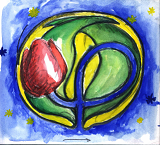 |
Tulip
4.6.0
Better Visualization Through Research
|
 |
Tulip
4.6.0
Better Visualization Through Research
|
00001 /* 00002 * 00003 * This file is part of Tulip (www.tulip-software.org) 00004 * 00005 * Authors: David Auber and the Tulip development Team 00006 * from LaBRI, University of Bordeaux 00007 * 00008 * Tulip is free software; you can redistribute it and/or modify 00009 * it under the terms of the GNU Lesser General Public License 00010 * as published by the Free Software Foundation, either version 3 00011 * of the License, or (at your option) any later version. 00012 * 00013 * Tulip is distributed in the hope that it will be useful, 00014 * but WITHOUT ANY WARRANTY; without even the implied warranty of 00015 * MERCHANTABILITY or FITNESS FOR A PARTICULAR PURPOSE. 00016 * See the GNU General Public License for more details. 00017 * 00018 */ 00019 ///@cond DOXYGEN_HIDDEN 00020 00021 00022 #ifndef GLPOLYQUAD_H_ 00023 #define GLPOLYQUAD_H_ 00024 00025 #include <tulip/tulipconf.h> 00026 #include <tulip/Coord.h> 00027 #include <tulip/Color.h> 00028 #include <tulip/GlSimpleEntity.h> 00029 00030 #include <vector> 00031 #include <string> 00032 00033 namespace tlp { 00034 00035 /** 00036 * @ingroup OpenGL 00037 * \brief General class used to render a connected group of quadrilaterals (textured or not) that shares edges as GlEntity 00038 * 00039 * This generic class is used to render a connected group of quadrilaterals (textured or not) that shares edges as GlEntity 00040 */ 00041 class TLP_GL_SCOPE GlPolyQuad : public GlSimpleEntity { 00042 00043 public : 00044 00045 /** 00046 * Default Constructor for initializing an empty polyquad 00047 * Use the addQuadEdge method to set the quads edges 00048 * 00049 * \param textureName The absolute path of the texture image file to use 00050 * 00051 * 00052 */ 00053 GlPolyQuad(const std::string &textureName = "", const bool outlined = false, const int outlineWidth = 1, const Color &outlineColor = Color(0,0,0)); 00054 00055 /** 00056 * Constructor for building a polyquad with spefific colors for each edges 00057 * 00058 * Pay attention to the order of the edges point in the polyQuadEdges vector. Indeed, to draw the following polyquad 00059 * 00060 * v2 00061 * v0+--------+--------+ v4 00062 * | | | 00063 * | | | 00064 * | | | 00065 * v1+--------+--------+ v5 00066 * v3 00067 * 00068 * The content of the polyQuadEdges vector should be {v0, v1, v2, v3, v4, v5} or {v1, v0, v3, v2, v5, v4} 00069 * 00070 * \param polyQuadEdges A vector containing the coordinates of the quad edges, its size must be a multiple of 2 because an edge is defined by 2 points 00071 * \param polyQuadEdgesColor A vector containing the edges's colors, its size must be equal to the number of edges defined by the polyQuadEdges vector 00072 * \param textureName The absolute path of the texture image file to use 00073 */ 00074 GlPolyQuad(const std::vector<Coord> &polyQuadEdges, const std::vector<Color> &polyQuadEdgesColor, const std::string &textureName = "", 00075 const bool outlined = false, const int outlineWidth = 1, const Color &outlineColor = Color(0,0,0)); 00076 00077 /** 00078 * Constructor for building a polyquad with a single color 00079 * 00080 * \param polyQuadEdges A vector containing the coordinates of the quad edges, its size must be a multiple of 2 because an edge is defined by 2 points 00081 * \param polyQuadColor The polyquad color 00082 * \param textureName The absolute path of the texture image file to use 00083 */ 00084 GlPolyQuad(const std::vector<Coord> &polyQuadEdges, const Color &polyQuadColor, const std::string &textureName = "", 00085 const bool outlined = false, const int outlineWidth = 1, const Color &outlineColor = Color(0,0,0)); 00086 00087 /** 00088 * Method to add a polyquad edge 00089 * 00090 * \param edgeStart The first end of the edge 00091 * \param edgeEnd The other end of the edge 00092 * \param edgeColor The edge's color 00093 * 00094 */ 00095 void addQuadEdge(const Coord &edgeStart, const Coord &edgeEnd, const Color &edgeColor); 00096 00097 /** 00098 * Virtual function used to draw the polyquad. 00099 */ 00100 void draw(float lod,Camera *camera); 00101 00102 /** 00103 * Method to set the polyquad color (all edges share the same color) 00104 */ 00105 void setColor(const Color &color); 00106 00107 /** 00108 * Method to set the polyquad outline color 00109 */ 00110 void setOutlineColor(const Color &color) { 00111 outlineColor = color; 00112 } 00113 00114 /** 00115 * Method to toggle polyquad outline 00116 */ 00117 void setOutlined(const bool outline) { 00118 outlined = outline; 00119 } 00120 00121 /** 00122 * Method to set the polyquad outline width 00123 */ 00124 void setOutlineWidth(const int width) { 00125 outlineWidth = width; 00126 } 00127 00128 /** 00129 * Method to translate entity 00130 */ 00131 void translate(const Coord &move); 00132 00133 /** 00134 * Function to export data in outString (in XML format) 00135 */ 00136 void getXML(std::string &outString); 00137 00138 /** 00139 * Function to set data with inString (in XML format) 00140 */ 00141 void setWithXML(const std::string &inString,unsigned int ¤tPosition); 00142 00143 private : 00144 std::vector<Coord> polyQuadEdges; // vector which contains polyquad edges, an edge being defined by a pair of Coord 00145 std::vector<Color> polyQuadEdgesColors; // vector which contains polyquad edges colors 00146 std::string textureName; 00147 bool outlined; 00148 int outlineWidth; 00149 Color outlineColor; 00150 }; 00151 00152 00153 } 00154 #endif /* GLPOLYQUAD_H_ */ 00155 ///@endcond